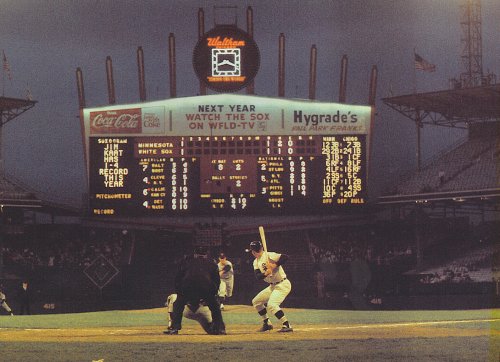Baseball History Comes Alive Now Ranked #2 by Feedspot Among All Internet Baseball History Websites and Blogs!
Guest Submissions from Our Readers Always Welcome!
Subscribe to Baseball History Comes Alive! to receive new posts automatically
“Baseball’s Historic Scoreboards” Photo Gallery
Click on any image below to see photos in full size and to start Photo Gallery:
- Demolition of Old Comiskey, September 12, 1991
- Baltimore,Memorial Stadium, 1956
- Scoreboard in Cleveland’s Municipal Stadium
- Baker Bowl
- Sportsman’s Park scoreboard
- Tiger Stadium
- Ebbets Field
- Polo Grounds
- Baltimore Memorial Stadium after Game One of the 1969 World Series
- Yankee Stadium
- Yankee Stadium
- Score board from the early days of baseball in Washington D.C.
- Wrigley Field scoreboard
- Unusual Herschel Green Stadium, home of the Nashville Sounds
- Crosley Field
- Ebbets Field scoreboard
- Exploding Scoreboard in Old Comiskey Park
- Crosley Field, 1949
- Braves Field
- Forbes Field
- Fenway Park Scoreboard
- Leon Culberson in Fenway Park
- The Monster as it appeared in 1965 with Veeck’s original paint scheme
- The scoreboard goes off!
- Bill Veeck, new owner of the Chicago White holding the keys to the park, December 16, 1975
Old Comiskey’s “Exploding Scoreboard” Debuted 58 Years Ago Today!
“Of all the unusual things my father did in baseball my favorite, hands down, was the exploding scoreboard.” –Mike Veeck
“What’s baseball coming to?”-Former White Sox manager, Jimmy Dykes
Many old-school baseball lifers reacted the same as Jimmy Dykes after seeing Comiskey Park’s exploding scoreboard for the first time. Dykes added: “All I know is that if I was a pitcher whose home run ball had started that Fourth of July celebration, I’d fire my next pitch at the head of the next hitter.”
The White Sox’ tradition-shattering scoreboard was unveiled 58 years ago this week, April 28, 1960, at a night game against the Indians. The $300,000 130-foot-wide “Monster” was the brainchild of Sox’ showman owner Bill Veeck, and featured fireworks, flashing strobe lights, sirens, a “Soxogram” message board, and multi-colored pinwheels after every home run hit by a White Sox player. Baseball historian Jerome Holtzman once called it a “screeching banshee.”
The board was officially christened on May 1, 1960, when Sox outfielder Al Smith set it off for the first time with a two-run homer off Jim Bunning in the bottom of the first against the Tigers.

View of Comiskey Park Exploding Scoreboard from outside the park
Veeck once claimed he got the idea for one of baseball’s greatest spectacles while watching a Jimmy Cagney movie: “This character in the film (“The Time of Your Life”) was always playing pinball machines. Toward the finish he finally hit the jackpot and there was the darndest racket and flashing of lights you ever heard or saw. Why can’t a ballpark generate similar excitement with sound and light?”
And since Veeck owned Comiskey Park…
One of the board’s biggest fans is current owner Jerry Reinsdorf: “I was awed when Veeck unveiled his explosive innovation. The revolutionary board seemed unbelievable — yet typically Veeck. It set the pattern for the sophisticated scoreboards of today.”
Not all of Bill Veeck’s stunts caught on. Some of them were harebrained for sure (like players in clamdigger pants and even in shorts, signing midget Eddie Gaedel, grounds crew in space uniforms, “Grandstand Managers’ Day” to name only a few); and one disastrous (Disco Demolition Night); but as the ultimate promoter, Veeck’s objective was always to make the baseball experience fun for the fans.
Chicago White Sox Gear from The MLB Shop
Some of his innovations were truly groundbreaking, like the signing of Larry Doby as the first African-American to play in the American League. Other lasting contributions included placing players’ names on the back of the unifoms, and prompting Harry Caray to sign “Take Me Out to the Ball Game” during the seventh-inning stretch. But there’s no doubt the White Sox’ exploding scoreboard was Bill Veeck at his best!
Bill Veeck, the ultimate baseball promoter, innovator, and hustler, was elected to the Hall of Fame in 1991.
Gary Livacari
Photo Credits: All from Google search
Information: Excerpts edited from 2015 article on Comiskey Park Exploding Scoreboard in Chicago Tribune online
Check out my two books, both now available on Amazon in e-book and paperback: “Paul Pryor in His Own Words: The Life and TImes of a 20-Year Major League Umpire” and “Memorable World Series Moments.” All profits go to the Illinois Veterans Foundation
We are a participant in the Amazon Services LLC Associates Program, an affiliate advertising program designed to provide a means for us to earn fees by linking to Amazon.com and affiliated sites. Click here to view Amazon’s privacy policy



























I remember that thing when I was a kid! It was definitely a treat to see it go off even though I was and still am an Indian’s fan!
Actually, the red center is not the original paint scheme. When the board debuted the center was painted a lighter royal blue. It was in the mid-60’s the center was painted red and the Cubs game was added (in dark blue) below the new red Balls/Strike area. The original royal/navy version only had room for four NL games – so one was always missing. The red center version, by adding the Cubs, showed all AL and NL games.
I say “original” but you probably figured out that the center part of the board is the same green 1950’s scoreboard – with the Sox-o-gram added on the left and the line-ups on the right. The top, where the old Chesterfield ad sat, was expanded to hold more ads. The clock, believe it or not, remained in the same place as in the green 1950 configuration – though its sponsor changed frequently.